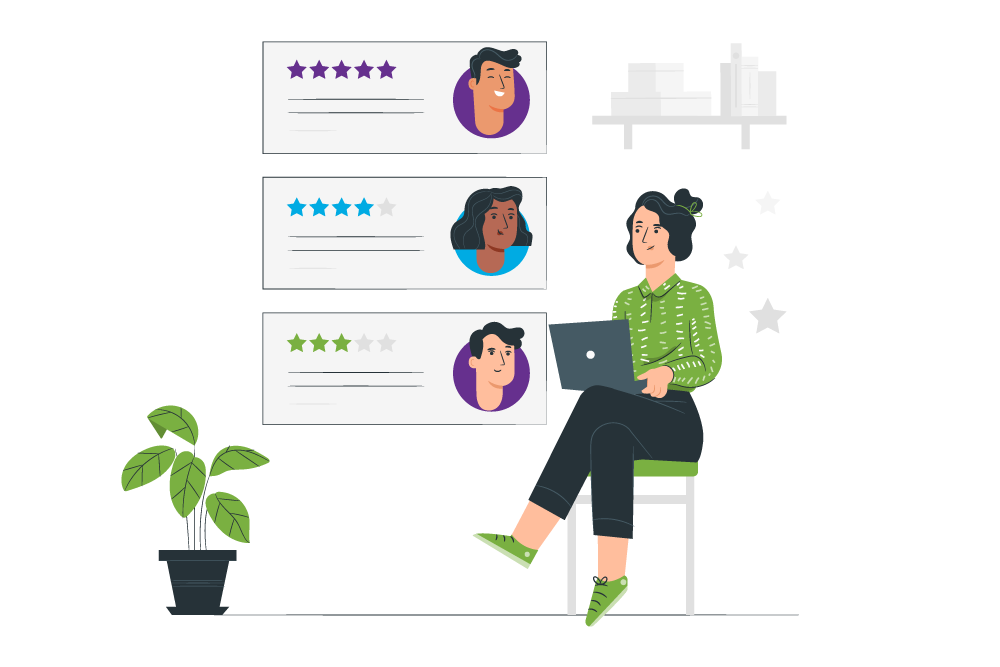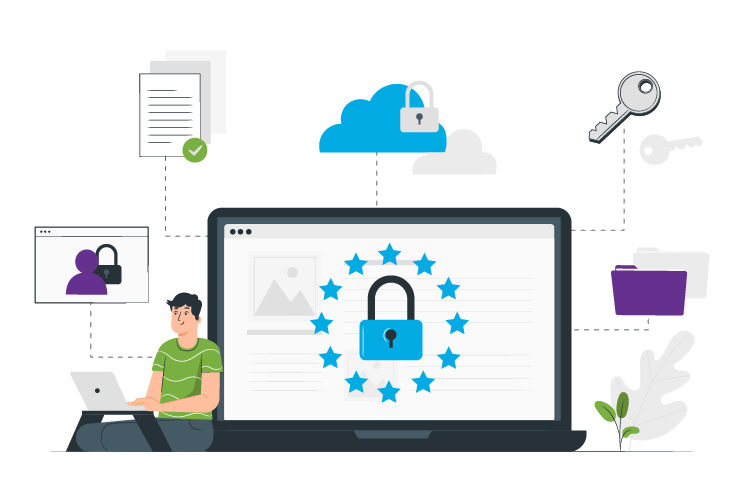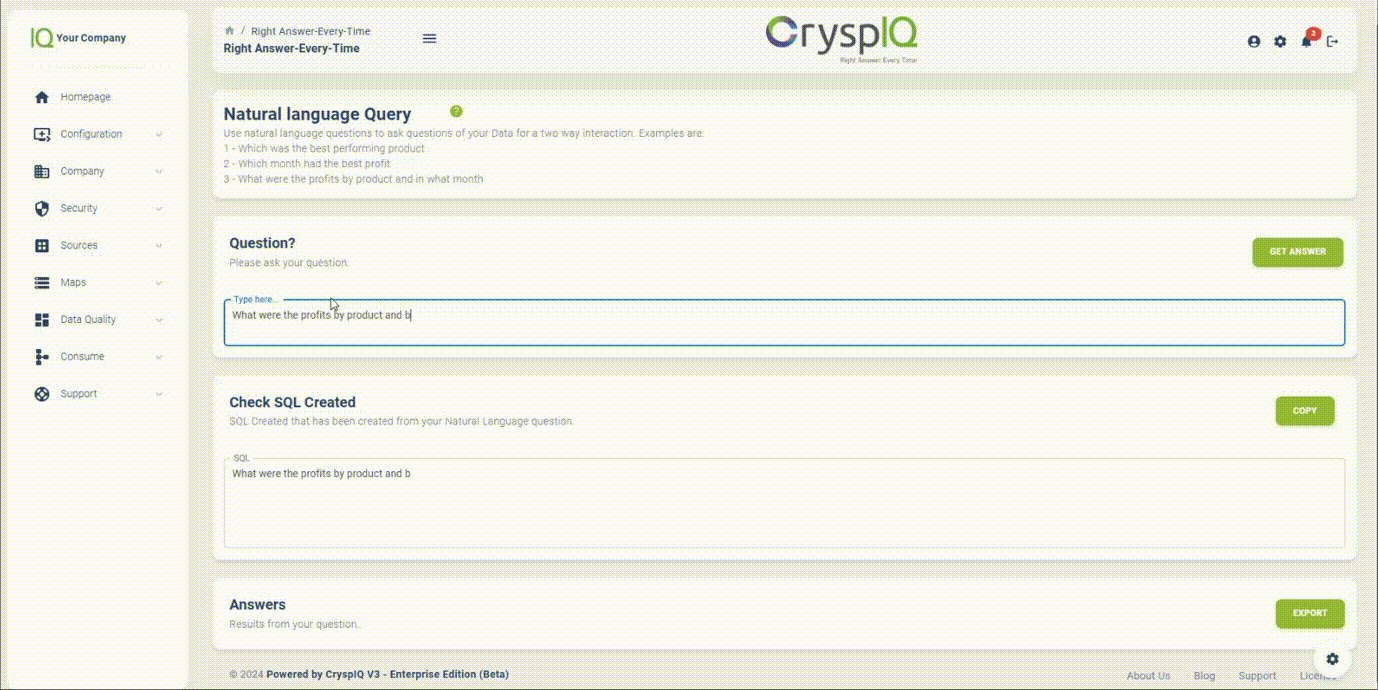Navigating CryspIQ
Provides you with a quick overview of the CryspIQ application and brief understanding of each functional component.
User Module
The User Module enables you to manage the users that have been assigned licenses within CryspIQ. Your licensing model is based of the number of users you have registered in Microsoft Azure AD to use CryspIQ.

Different types of users will be required for your organisations. This is completely separate to Data Access which is covered off in the Security section. You can have the following types of users, which can perform difference application functions:
- Company Administrator (manages source connections, creates mappings and manages Data Quality issues)
- Normal Users (includes anyone building queries or using data from CryspIQ).
- Application Users (system to system communication using APIs)
Licensed Users
You have the ability to:
- Create and add new users up to the licence limit.
- Edit and update your users
- Delete users, which removes users from your user license count.
Application Roles
Assign application level roles to each user, the different types of users are outlined in the table below:
| User Type | Properties |
|---|---|
| Company Administrator |
|
| Normal Users |
|
| Application Users |
|
Licensing
User allocations available in each version are outlined below:
- Up to 5 users (combination of administrator and user Role types) are allowed in the Lite version.
- Up to 20 users (combination of administrator and user Role types) are allowed in the Pro version.
- Unlimited users (combination of administrator, user and application Role types) in the Enterprise version.
Security Module
The Security Module enables you to manage the security and control access to your data. CryspIQ integrates seamlessly with your existing Microsoft Active Directory (AD) and enables you to manage the security of your data to a granular level.
 Key Benefits:
Key Benefits:- Security managed in a single place.
- Applied on a single database schema.
- Simplified maintenance processes.
Ensure that all your data is secured and manage your compliance with:
- Privacy laws in your Country.
- Sarbanes-Oxley Act of 2002 (commonly referred to as “SOX”).
- Security of Critical Infrastructure Act 2018 (SOCI).
- Setting up AD Security groups
- Applying security at columnar level.
- Applying security at a field level.
Data Access Levels
Manage your data access control. You have the ability to:
- Create and add new groups and connect to the AD Group.
- Assign data security level to AD groups.
- Update your roles and connections to AD groups
- Delete roles and connections to AD Group
Object Security
Secure your data at a field level for identified fact types. Using the levels outlined earlier, Data will default to level 1, but company administrator can change this to the appropriate level. Example "SalaryPayment" data would normally be a level 4.
Contextual Security
Secure your data at a columnar level. Using the Levels outlined earlier, data will default to level 1 as open, but company administrator can change this to the appropriate level. Example would be "Date of Birth" which is PI and should be classified as level 4.
Licensing
All versions have access to the same data security features.
Sources Module
The Sources Module enables you to manage the different source systems and source messages that you wish to load into CryspIQ.
As there are no constraints on the number of source messages, you have no restrictions around how much data you can load.
 Key Benefits:
Key Benefits:- Unlimited source messages.
- Load and store all your data with context.
- Build up the single source of truth for your organisation.
All licenses have direct access to the existing source system plug-in library. These plug-ins contain:
- Pre-built source system extractors,
- Source message structures,
- Predefined maps into CryspIQ.
- Re-use an existing system plug-in and adjust it to fit your needs.
- Build your own source system plug-in and add it to the global library.
Upload Data File
Enables the company administrator to upload a source system data object in xml or csv format.
Messages
Manage your source message structures (schemas) from the source systems. You have the ability to:
- Add a new source message
- Add metadata associated with the source message.
- Assign data ownership - data steward and function
- Manage fields in message
- Edit an existing message
- Delete an unwanted message (soft delete)
Licensing
There are no limits or constraints to the number of source systems that you can have in the Lite version, Pro and Enterprise version.
Maps Module
The Maps Module focuses on helping you prepare and organise all your data for CryspIQ. It enables you to apply multiple methods and defaults to prepare and organise your data into the universal context.
 Key Benefits:
Key Benefits:- Removes the manual efforts required to discover data.
- Removes the requirement for intepretation of the data.
- Adds contextual metadata to data.
- Provides consistent understanding of terminology used.
- Provides traceability and lineage back to source record.
- Manage a library of maps for source messages to the CryspIQ.
- Re-use an existing map and adjust it to fit your requirements.
- Build your own map and add it to the global library.
- Apply customised methods and defaults to your data.
Manage Maps
Manage your organisation mappings for each source message:
- Create new mapping, and add methods and defaults where required.
- Capture linkkey field for traceability back to source record.
- Add search metadata, to assist users to find what they're looking for.
- Update existing mapping,
- Add / edit / delete methods
- Add / edit / delete defaults where required.
- Delete existing mapping(s)
Methods
Manage the rules / logic / methods that can be applied to each mapping at a field level:
- Create new method
- Update existing method
- Delete existing method
Defaults
Manage the Defaults that can be applied to each mapping at a field level:
- Create new defaults
- Update existing defaults
- Delete existing defaults
Licensing
There are no limits on the number of maps that can be created in the Lite version, Pro and Enterprise version.
Consume Module
The Consume Module focuses are simplfying how your users find, use and access the data they require. This module caters for both types of users (technical vs non-technical) depending on their preference.
 Key Benefits:
Key Benefits:- Data is ready for use once it has been loaded.
- Ask questions of your data using everyday language.
- Have a two-way conversation with your data.
- No technical knowledge is required.
- Natural language query model (Text to SQL).
- Build your own SQL queries.
- Existing query library.
- Enabling scenario notifications.
- Application to application communication.
Query Library
You are provided with the query library which contains pre-built queries which can be re-run by anyone across your organisation. Security will be applied on the results returned, so people will only see what they are allowed to see.
Query Builder
You also have the ability to build your own query and add it to the organisation library for others to use. You have the ability to re-use an existing query, tweak it to fit your requirements and then save it as new query in the library.
Some features of the query builder are:
- Drag and drop functionality query builder by selecting your facts and the data required.
- Preview the query outputs
- Text box for standard Structured Query Language (SQL)
Natural Language Query
This functionality will leverage the natural language query model libraries to use human language to build the SQL queries required to provide your results. See it in action:

Scenerio Triggers
Build conditional / scenario-based data triggers to drive your organisation with Data from production control systems (OT) and other technologies (IT). Query data from production control systems (Operational Technologies) and other technologies (Information Technology) in the same way in CryspIQ. Use these queries to investigate difference possible solution scenarios and build triggers to drive your organisation forward.
Application to Application Calls
Build applications which utilise the CryspIQ Data as the single source of truth for the organisation. Use triggers and organisation scenarios to drive automation down stream organisation processes. Set up connections to CryspIQ using Rest or Webhooks functionality.
Licensing
The query Library, query builder and natural language query features are available in the Lite, Pro and Enterprise versions. The scenario triggers and application to application features are only available in the Enterprise version.
Data Quality Module
The Data Quality Module focuses on supporting your data governance journey and ensuring that all data provided conforms to the required level of quality criteria.
 Key Benefits:
Key Benefits:- Reliable insights require reliable data.
- Visualise the quality of data being provided.
- Build trust and reliance on your data.
- Provides the foundation for informed decision-making.
- Functional dashboards.
- Data steward dashboards.
- Local data quality Rules.
- Data quality notifications.
- External API methods.
Function Dashboards
A dashboard with drill through capability that assists the data owner to understand data quality issues identified for their organisational function. The dashboard is live and can be viewed across the organisation, thus all parts of the organisation will be discussing things from a single source. For large organisations, this allows data quality to measured and good data governance processes to be implemented to avoid re-currence.
Data Steward Dashboards
A dashboard with drill through capability that assists the data steward to understand data quality issues identified. The data steward is responsible to ensure that the issues identified are fixed at source and records re-submitted. It's a live dashboard, so the data quality issues will remain in place until they are resolved.
Local Data Quality Rules
Build you data quality rules / methods that will be applied to the data as it arrives. The rules are categorised / flagged according to the data quality dimension that they fall under according to the DAMA framework. This categorisation is done during the inital set up of the methods.
Data Quality Notifications
Configure data quality notifications to be sent the data steward, when new issues are identified.
External API methods
Use external application programming interfaces (API) to validate the quality of you organisation Data. API method rules need to be categorised / flagged according to the data quality dimension that they fall under according to the DAMA framework. This is done during the set up of the external api connection.
Licensing
The dashboards, local data quality rules and notifications are available in the Pro. and Enterprise version. The external API methods are only available in the enterprise version.
Data Science Module
 Key Benefits:
Key Benefits:- Provides a solid data foundation for your ai journey.
- Provides your ai models with the depth of data required.
- Provides contextual metadata and good quality data.
- Provides standardised data structures for your ai experiments.
Toolsets that enrich your data with organisational context and check quality are rare, and this becomes the bedrock for innovation, providing your ai models with the depth needed for accurate predictions.
Features include:- Data science library.
- Re-use an existing Data Science algorithm.
- Build your own data science models.
Please note that data science module will only be available in Q2 2025 Release, but the data foundation is available (Universal Context).
Data Science Library
Access to the Data Science library with pre-built Data Science algorithms. You have the ability to re-use an existing Data Science algorithm, tweak it to fit your requirements and then save it as algorithm in the library. You have the ability to use the data stored in CryspIQ to build your own Data Science algorithms and models for use across your organisation. This would require the Application User role.
Unstructured Data Reader
This leverages the Microsoft Azure Machine Learning (ML) capability and enables you to build models of your documents which are in PDF format. The ML models can then be trained to improve their accuracy.
Licensing
The Data Science features are only available in the Enterprise version.